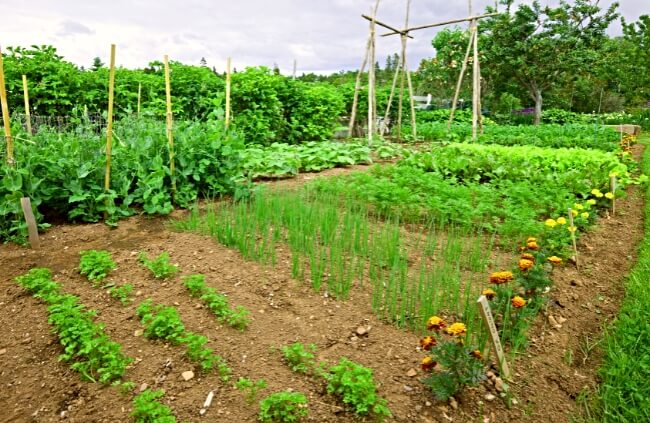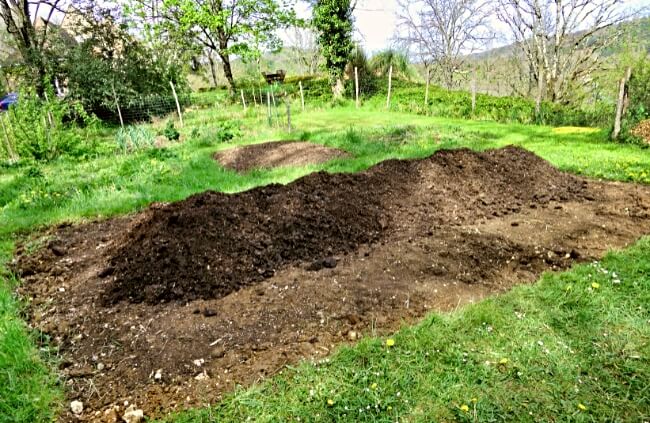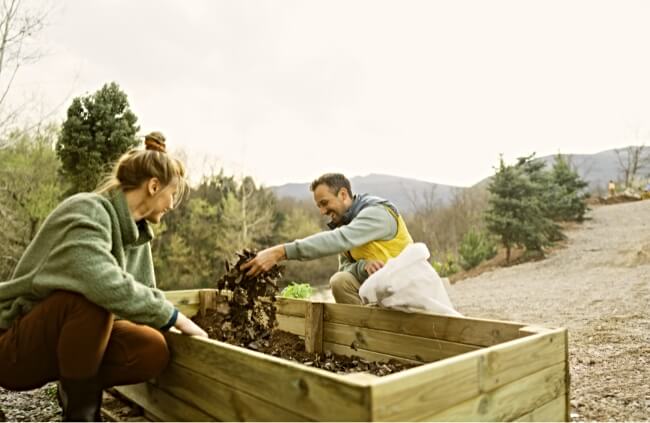If I told you that you could grow strong plants, improve your garden soil, and help to encourage wildlife, by putting less effort into your garden, it would sound too good to be true. But that is exactly what no dig gardening does, and it is what we have been practising for years.
There are swathes of traditional growers, particularly in commercial farming, who live strictly by tilled, heavily cultivated soil, and they are not wrong to do it. However, by reducing how often you intervene with soil structure your impact on the planet becomes so soft, that it responds by improving itself.
I want to take this opportunity to share our experiences of no dig gardening, and hopefully inject some enthusiasm into this simple method of layering goodness into your veggie patch.
More...
What is No Dig Gardening?

No dig gardening is, very much, what it says on the tin. There are a few different methods to it, but in essence it is about building a garden that is less demanding on the earth and feeding the soil in more natural ways.
The most typical form of no dig gardening is just laying cardboard over your soil (grassy, sandy, clay, whatever) and then piling compost over the top. Over time, worms work the cardboard and soil down into the soil, and you easily kill off grass and weeds below by blocking the light from them.
The whole thing is a very basic replica of what happens in nature: Trees, shrubs, and even long grass drop leaves to form a weed and competition suppressing mulch around their feet; that rots down and feeds the soil, which stays open and well-drained; the trees thrive as a result.
No dig gardening creates that, but instead of feeding trees, you feed yourself.
What are the Benefits of No Dig Gardening?
For brevity, here is a brief list of the benefits of no dig gardening, for you and for nature, followed by how and why they work:
- Healthier crops
- Reduced watering
- Improved flood and fire protection
- Uses kitchen waste
- Less effort than other systems
- Supports wildlife
- Reduces pests
- More growing space
The benefits of no dig gardening are never as apparent as at harvest time. Crops grown in a simple no dig garden grow more evenly, and are more abundant. This takes a year or two to achieve, but is a result of overall soil improvement, adding moisture retentive organic matter and improving drainage in the process.
Not to mention that the whole thing takes a fraction of the effort of traditional vegetable gardening.
Because no dig gardening is not restricted by raised beds, you also get more square footage of growing space, so boost your harvests that way too. Paths can be as wide or narrow as you need them to be, provided you maintain them and avoid walking on the soil.
No dig gardening has benefits to nature as well as to you. By providing loose topsoil packed with organic matter, you encourage worms and offer habitats for overwintering bugs. This creates a balanced garden ecosystem, which helps to reduce pest species.
The wider impact of no dig gardening should not be diminished either. By improving the health of your soil, adding moisture-retentive organic matter, and opening soil structure, you are doing your bit to reduce rainwater runoff, which reduces flooding and fire risks in one fell swoop.
What are the Negatives of No Dig Gardening?
No dig gardening is not perfect. Even I will admit that. It requires more compost than most other forms of veggie gardening, and a more active approach to home composting in general. That means it's not ideal for small spaces.


Get Your Free Guide:
Master Growing Australian Natives eBook
A Must Have Complete Guide for Every Australian Garden
Get Your Free Guide:
Master Growing Australian Natives eBook
A Must Have Complete Guide for Every Australian Garden
Unlike other types of raised beds, no dig gardens can look a little bit messy if they are not kept tidy, with at least an annual refresh or sweep of your paths.
And, if you are building a no dig garden on heavy clay, a no dig garden can be damp and slow-draining in the first year or two (over time, it is notably better so patience is a virtue).
In short, the negatives of no dig gardening:
- Slow to progress on a clay base
- Limited use in small spaces
- Requires regular tidying
- Needs a lot of compost
What Can You Grow in a No Dig Garden?
No dig gardening does not limit what you can grow. If you can grow it in good garden soil, you can grow it in a no dig garden. Depending on the subsoil you start with, Mediterranean herbs will struggle in a no dig garden as the soil tends to be too rich.
And if you want to grow veggies that like poor soil and drainage, like carrots, you will need to implement crop rotation so that they grow more evenly. This is just because the nutrients and moisture in a recently mulched no dig bed are spread evenly. Carrots like to search deeper for goodness, so use a patch that you grew tomatoes or beans in the previous year to sow carrots.
How to Start a No Dig Garden
Use this next section as a guide to the mechanics of no dig gardening. If you are completely new to gardening, we will share some tips about how and why these tricks work as we go, but hopefully it serves as a straightforward introduction to building your first no dig bed.
Step 1: How to prepare the ground for no dig gardening
Ground preparation for your no dig garden will vary depending on the soil you have, and the condition it's in. Poor, unworked garden soil, or anything that has been heavily compacted by building work, vehicles, or heavy machinery (often a problem for new build homes), will need aerating before you start.
Other than that, you can build a no dig garden with no soil preparation at all.
To aerate compacted soil, just get a garden fork and jam it deep down into the soil every 15-20 cm, wiggling it as you go. This opens up soil structure, allows initial drainage once you apply no dig layers, and gives worms space to do their work.
Note: If your garden is concreted or paved, you will need to remove and replace the concrete and hardcore with reasonable quality soil, at least to the original ground level, and introduce worms. No dig gardening is good, but not that good!

Step 2: Why mulch is important for no dig gardens
After preparing the ground, the first step of any no dig garden is to mulch. There are two ideal materials for this: cardboard and newspaper. Never use synthetic materials for no dig gardening, as the whole point is that everything is worked back into the soil.
- Cardboard is great because it is readily available (your local grocery store will usually be happy to give you loads of used cardboard, and off-licences get through tons of it). Because cardboard has air pockets between corrugations, it rots down faster than paper.
- Paper is more effective as a mulch than cardboard, but it is hard to get enough to cover large beds. Use at least six sheets of newspaper as a layer. A multi-layered newspaper mulch takes longer to rot down, so prevents weeds for slightly longer than cardboard.
Whichever mulch you use, place it down, then soak it completely. This flattens it against the ground, so you will not get air pockets beneath your compost.
Step 3: Adding compost to your no dig garden bed
I will go into more detail about how to add compost to a no dig garden later, but for a simple no dig bed, just add a healthy layer of compost on top of your cardboard.
Remember, in the first year, you will be growing entirely in this compost, so make sure you add at least 15 cm of compost, if not more. You will be sowing and planting directly into the compost, and watering it regularly. That layer will reduce by at least half over the first growing season, and need topping up each year with different materials.
Step 4: Lay out your paths
And finally, you are ready to add paths. Our no dig allotment is all about practicality and access, so our paths are 1m wide (enough for a wheelbarrow), but if you are working with a smaller space, you can pack more in.
The paths for a no dig garden need to be permanent fixtures, but they want to drain, so use wood chips or gravel so rain still falls evenly through the path.
As you walk over your no dig beds, you will compact the soil. The more often you do that, the worse the growing conditions get, so plan out growing space into evenly sized spaces so you can rotate crops each year, and will not be restricted by path layouts.
How to Plant in a No Dig Garden
As long as you plant into compost, rather than actively rotting materials, there are no special considerations for planting in a no dig garden.
You can plant seedlings directly into the beds, and sow directly onto the raked surface, just as you would in any other vegetable bed or container. Sow thinly to reduce how much you need to thin out later.
Try to plant in neat rows, and spend time planning your plot layout each year so you can reach crops and weed in between them without standing on no dig beds or compacting the compost.
Different No Dig Methods
There are three no dig methods, and all have their benefits, but compost mulching (the basic method) is the one I find most useful, and gives the best results.

Compost Mulching
You can use different types of compost to mulch. Some will be richer, some will add more nitrogen, and others will help to improve drainage. But, essentially, you’re building a humus rich layer over time. The earth below your no dig bed will be getting richer and richer, with more life every day.
And, by using rotted compost to mulch with, planting into your no dig garden becomes so much easier.
Hay Mulching
Some no dig gardeners suggest using hay as a mulch throughout the year. We tried it here once, and it failed miserably, other than as an affordable way to hill up potatoes.
Hay rots down slowly, and creates great habitats for bugs. This can be positive, but in a productive vegetable garden, can be problematic. On the whole, I would steer clear of hay, unless it is being used to block out light, and composted elsewhere later.
Lasagna Mulch
Lasagna mulching your no dig garden does work pretty well. It’s a little bit more complicated, but it means you can practise no dig gardening in smaller spaces without the need for a large compost bin.
Get your no dig garden started by mulching with cardboard as usual, and then add a layer of grass clippings and/or kitchen waste, followed by hay, then dried materials like fallen leaves. This lasagne of organic matter will rot down into beautiful compost with the help of garden worms within a year.
Leave the layers to settle for a week before planting, and then plant into pockets filled with peat-free garden compost.
Potential Problems with No Dig Gardens
As I mentioned earlier, no dig gardens are not perfect, and they do not solve all problems for everyone. I find them to be ideal for me, and they reduce my workload immensely, and my soil quality has improved beyond recognition simply through mulching. But…
No dig gardens can attract pests, provide easy tunnelling spots for rodents, and offer warm, moist, soil for pest insect larvae through winter.
Chances of disease are reduced in general with no dig gardens, it will take a few years for that sort of activity to really get to work. For instance, worms are the workforce of a no dig garden, and their poo is packed with positive bacteria which helps to prevent fungal problems, but that takes time.
In the first few years, you will need to keep an eye on moisture levels as the cardboard or paper mulch holds excessive moisture in the compost. Thankfully, once the mulch rots away, those problems disappear.
Frequently Asked Questions About No Dig Gardening

Can you walk on a no dig garden?
Avoid walking on no dig gardens wherever possible. They are not muddy like garden borders, but the idea of no dig is to improve soil structure, not compact it. Walking on any garden bed is bad for it, and that is the same for no dig.
Is no dig gardening expensive?
If you do not have your own supply of compost at home, no dig gardening can be expensive to begin with, requiring at least 50 L of compost per square metre (about $10 depending on the brand and where you buy it).
Is no dig worth the effort?
Starting and maintaining a no dig garden are less effort than, and cheaper than, building and filling raised beds. They are worth every second you spend, and the time you win back can be spent kicking back with a beer in the garden while you watch your harvests grow.
How deep should a no dig bed be?
No dig beds should be about 15 cm deep. An absolute minimum depth of compost would be about 10 cm but, essentially, the more the merrier.
Can you do no dig gardening over grass?
You can start a no dig garden directly on top of an existing lawn. Make sure to mulch with cardboard before adding your compost, and make sure the compost layer is at least 15 cm deep (the depth needed to block light and stop grass coming through).
How do you plant potatoes in a no dig garden?
Planting potatoes will differ depending on the age of your no dig garden. Potatoes should be planted about 10cm deep (so the base of the planting hole is 3x the height of the potato), but with loose soil beneath them too. In some cases that will mean covering potatoes with extra compost for new no dig beds. After that, mulch with straw to block out light as tubers develop.
Can you use top soil for no dig gardening?
You can use topsoil for no dig gardening but it is not recommended. The purpose of no dig is to add organic matter, rather than soil, to your soil. Over time this improves drainage and everything else. Adding top soil is cheap, but not as effective.
What is the ideal size for a no dig bed?
For most people, your no dig bed should be about 1.2m wide. That will give you plenty of room, without the need to tread on the compost. Split those sections into 2.4m lengths so you can keep logical divisions for different vegetables.
Embark on Your No Dig Gardening Journey
No dig gardening has revolutionised my allotment and boosted our harvests in ways I still find hard to comprehend. We do not garden intensively, and allow for comfortable paths, with flower beds intermingled too. If you really wanted to go for self-sufficient gardening, no dig is definitely the way to do it.
Above everything else though, no dig gardening is good for you, and your land. For that reason alone, I encourage you to go out and set up your own no dig garden beds. It is worth it.
Published on December 23, 2023 by Gary Clarke
Last Updated on September 20, 2025


Congratulations on such an attractive well set out blog! The content was informative and easy to read, and I love the way you gave an explanation of why certain methods work or don't work as well. Thanks you.
Hi Kerry,
Thank you for the kind feedback! I’m glad you found the blog informative and easy to navigate. I look forward to sharing more helpful content. If there’s anything specific you’d like to see, just let me know. Thanks again!
Best regards,
Gary Clarke